AMD Threadripper Pro Review: An Upgrade Over Regular Threadripper?
by Dr. Ian Cutress on July 14, 2021 9:00 AM EST- Posted in
- CPUs
- AMD
- ThreadRipper
- Threadripper Pro
- 3995WX
CPU Tests: Simulation
Simulation and Science have a lot of overlap in the benchmarking world, however for this distinction we’re separating into two segments mostly based on the utility of the resulting data. The benchmarks that fall under Science have a distinct use for the data they output – in our Simulation section, these act more like synthetics but at some level are still trying to simulate a given environment.
DigiCortex v1.35: link
DigiCortex is a pet project for the visualization of neuron and synapse activity in the brain. The software comes with a variety of benchmark modes, and we take the small benchmark which runs a 32k neuron/1.8B synapse simulation, similar to a small slug.
The results on the output are given as a fraction of whether the system can simulate in real-time, so anything above a value of one is suitable for real-time work. The benchmark offers a 'no firing synapse' mode, which in essence detects DRAM and bus speed, however we take the firing mode which adds CPU work with every firing.
The software originally shipped with a benchmark that recorded the first few cycles and output a result. So while fast multi-threaded processors this made the benchmark last less than a few seconds, slow dual-core processors could be running for almost an hour. There is also the issue of DigiCortex starting with a base neuron/synapse map in ‘off mode’, giving a high result in the first few cycles as none of the nodes are currently active. We found that the performance settles down into a steady state after a while (when the model is actively in use), so we asked the author to allow for a ‘warm-up’ phase and for the benchmark to be the average over a second sample time.
For our test, we give the benchmark 20000 cycles to warm up and then take the data over the next 10000 cycles seconds for the test – on a modern processor this takes 30 seconds and 150 seconds respectively. This is then repeated a minimum of 10 times, with the first three results rejected. Results are shown as a multiple of real-time calculation.

Normally DigiCortex likes memory bandwidth, but most of the TR Pro CPUs wilted in this test. The only mode that did not is the 3995WX in 64C/64T mode, perhaps showcasing this test runs better without SMT enabled.
Dwarf Fortress 0.44.12: Link
Another long standing request for our benchmark suite has been Dwarf Fortress, a popular management/roguelike indie video game, first launched in 2006 and still being regularly updated today, aiming for a Steam launch sometime in the future.
Emulating the ASCII interfaces of old, this title is a rather complex beast, which can generate environments subject to millennia of rule, famous faces, peasants, and key historical figures and events. The further you get into the game, depending on the size of the world, the slower it becomes as it has to simulate more famous people, more world events, and the natural way that humanoid creatures take over an environment. Like some kind of virus.
For our test we’re using DFMark. DFMark is a benchmark built by vorsgren on the Bay12Forums that gives two different modes built on DFHack: world generation and embark. These tests can be configured, but range anywhere from 3 minutes to several hours. After analyzing the test, we ended up going for three different world generation sizes:
- Small, a 65x65 world with 250 years, 10 civilizations and 4 megabeasts
- Medium, a 127x127 world with 550 years, 10 civilizations and 4 megabeasts
- Large, a 257x257 world with 550 years, 40 civilizations and 10 megabeasts
DFMark outputs the time to run any given test, so this is what we use for the output. We loop the small test for as many times possible in 10 minutes, the medium test for as many times in 30 minutes, and the large test for as many times in an hour.
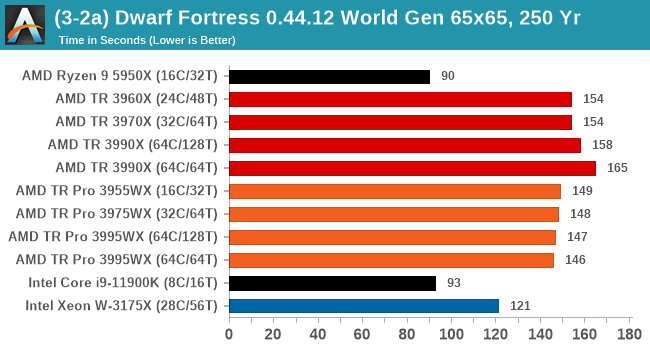

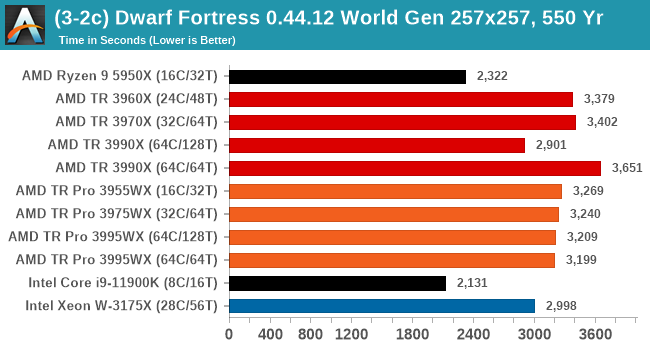
As a mostly ST test, the consumer processors do best here. However overall, TR Pro does better than TR.
Dolphin v5.0 Emulation: Link
Many emulators are often bound by single thread CPU performance, and general reports tended to suggest that Haswell provided a significant boost to emulator performance. This benchmark runs a Wii program that ray traces a complex 3D scene inside the Dolphin Wii emulator. Performance on this benchmark is a good proxy of the speed of Dolphin CPU emulation, which is an intensive single core task using most aspects of a CPU. Results are given in seconds, where the Wii itself scores 1051 seconds.
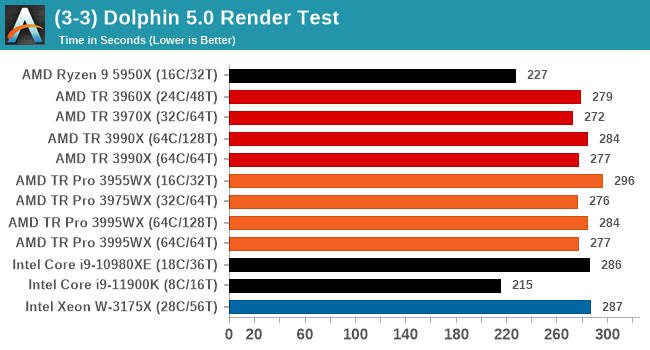
Factorio v1.1.26: Link
One of the most requested simulation game tests we’ve had in recently is that of Factorio, a construction and management title where the user builds endless automated factories of increasing complexity. Factorio falls under the same banner as other simulation games where users can lose hundreds of hours of sleepless nights configuring the minutae of their production line.
Our new benchmark here takes the v1.1.26 version of the game, a fixed map, and uses the automated benchmark mode to calculate how long it takes to run 1000 updates. This is then repeated for 5 minutes, and the best time to complete is used, reported in updates per second. The benchmark is single threaded and said to be reliant on cache size and memory.
Details for the benchmark can be found at this link.
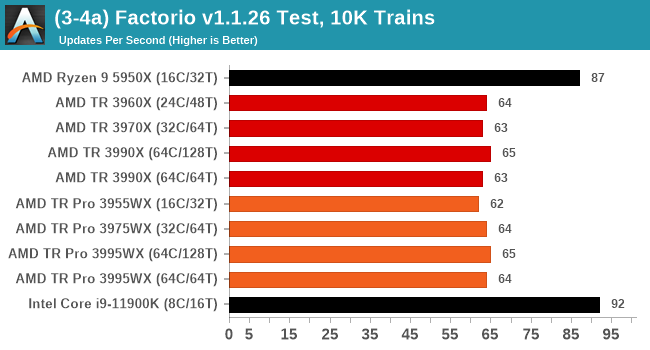

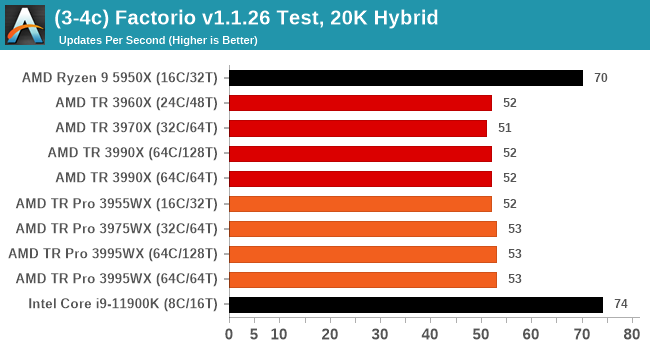












98 Comments
View All Comments
Rocket_Scientist - Friday, July 16, 2021 - link
I want to know who spends 5 grand on a processor but doesn't spend the few extra dollars to utilize all 8 memory channels!Mikewind Dale - Friday, July 16, 2021 - link
The 3955WX processor "only" costs $1,150, while each stick of 64 GB RAM costs $350.And I wanted to keep some empty slots in case 128 GB RDIMMs became affordable. But I didn't know that using 6 channels would cause so much performance degradation.
mode_13h - Saturday, July 17, 2021 - link
> who spends 5 grand on a processor but doesn't spend> the few extra dollars to utilize all 8 memory channels!
Although I tend to agree, the article did reveal some benchmarks where the additional bandwidth provides negligible benefit.
lmh - Tuesday, July 27, 2021 - link
Can you share what memory bandwidth you actually measured in the 3955WX 8-channel configuration?McFig - Wednesday, July 14, 2021 - link
There’s an error in the table “AMD 32-Core Zen 2 Comparison”: The MSRPs are mixed up.McFig - Wednesday, July 14, 2021 - link
Also: “code bath”; “Undreal” (I’m guessing should be “Unreal”?); “but also the updates” (e.g. could be “but also there were significant updates”)SarahKerrigan - Wednesday, July 14, 2021 - link
I kind of like "Code Bath."Threska - Wednesday, July 14, 2021 - link
" This is part of AMD’s guaranteed supply chain process, allowing OEMs to hard lock processors into certain vendors for supply chain end-to-end security that is requested by specific customers."I ASSUME that's a feature a certain OS vendor can't access.
"Only select vendors seem to have access/licenses to make WRX80 motherboards, and your main options are:"
I've seen the Giga offered as a burn-in special with a bundled processor, making it a better deal. The Asus is nice but I have to wonder if it's worth all the features.
DesireeTR - Wednesday, July 14, 2021 - link
No, It's worse. There's article about AMD Platform Secure Boot Feature (PSB) by servethehome together with Dell EMC. It basically burns permanently a public key of the OEM into the EPYC processor. It creates a guarantee that both motherboard and processor are not tampered. If you move your processor from OEM A that enabled PSB to motherboard of OEM B, AMD Secure Processor considers that as tampering and stops it working. The reverse is true.Some OEM are very strict (Dell EMC does this by hardware burn-in), some are less strict (HPE use
DesireeTR - Wednesday, July 14, 2021 - link
HPE only locks the public key in the firmware, and perform tamper check on BIOS only). And I guess before long, all PRO processor might get the same PSB feature too.